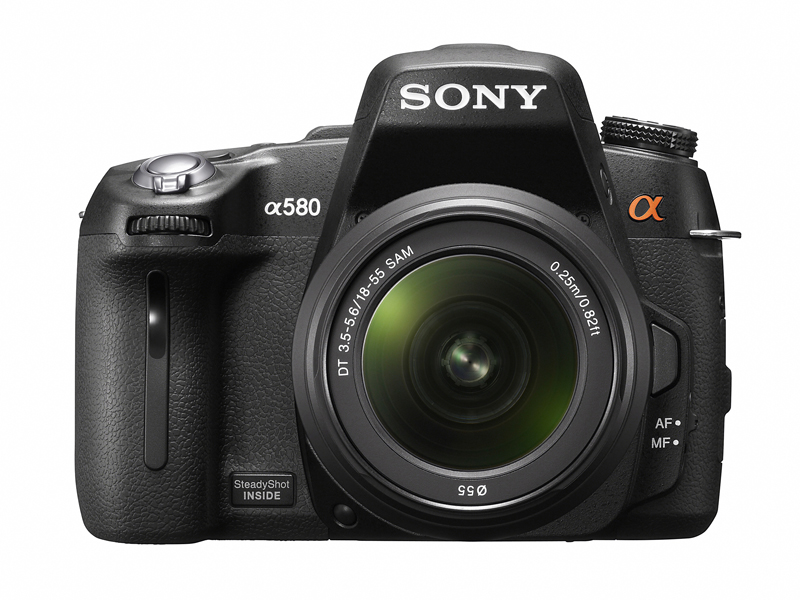Why you can trust TechRadar
Perhaps the greatest change from its predecessor concerns the Alpha 580's new sensor and its video-capturing capabilities. The Exmor APS HD CMOS chip provides and effective resolution of 16.2MP, and, as with all other Alpha DSLRs, the SteadyShot Inside system claims to offer a benefit of 2.5-4 EV stops when used with Sony or older Minolta A-mount optics. It works in tandem with the BIONZ processor which applies dual noise reduction to images, and it's also fitted with Sony's dual anti-dust system for keeping it spotless.
Full HD recording at 1,920x1,080i is complemented by reduced settings of 1440x1080p and 640x480p, while stereo sound recording is provided by the in-built microphones. For the purpose of playing back footage, a small speaker can be found to one side of the body, located just above a port for attaching external microphones and remotes.
The Sony A580 incorporates a new focusing system, comprising 15 points in total with 3 of these being cross type. Four are limited to being assist points which means they aren't available for manual selection, although the remaining eleven at the user's disposal should still provide enough control for most situations.
The points take up reasonable portion of the frame, which, together with the heightened sensitivity of the three cross points, means that most subjects are promptly bought to focus.
Impressively, poorer lighting conditions don't prove to be too great an obstacle, with speed and accuracy maintained to a very good standard, although some of the peripheral points prove to be unreliable should they be manually selected; although fine in good light, they can sometimes completely fail to focus on low-contrast subjects, subjects which the more sensitive points can pick out with ease.
With no autofocus available while shooting video, the scene needs to be focused before recording begins, ideally at the aperture and position which should maintain focus throughout the recording. The speedy focusing system ensures this all happens promptly, while the high resolution of the LCD makes it easy to check whether the subject keeps its focus should it, or the camera, move.
Combined with the LCD's articulation and its reasonably wide viewing angle, this makes it perfect for shooting from a number of angles, all the while maintaining accurate focus and composition. The kit lens may not offer a proper manual focus ring for the task, instead being performed by rotating the front of the lens's barrel, but if the camera is held at waist level with the screen pulled up and out this doesn't pose a problem, as the length of the optic allows for any adjustments to be conveniently made with the forefinger.
Thanks to the above, and the dedicated movie-recording button, shooting movies is fairly effortless. With no autofocus there's no sound to worry about from the camera's lens, while the action from manual focusing is barely audible, particularly when there are other sounds being recorded, although care needs to be taken at either end of a lens's focusing range as the running into either point can be heard. As long as the scene isn't panned too abruptly, the feed is smooth and free from any wobbling. In fact, the most noticeable artefact is generally a fine pattern of noise over darker areas.
Sony's Sweep Panorama mode is easily accessed via the mode dial, and on-screen instructions guide you through the process of creating instant panoramas. Presumably due to the smaller size of each individual image, processing is quick and the complete image only takes around a second or so to pop up on the LCD screen, although some panoramas result in stitching errors when viewed close up (which can be remedied by practice and correct technique).
While it's an impressive feature, and undoubtedly the best of its kind, the limited manual control and incompatibility with Raw shooting perhaps makes it better suited to Sony's Cyber-shot cameras than its DSLRs, which are more likely to be found in the hands of the more discerning photographer.
In its Speed Priority burst mode, the A580 can also shoot full-resolution images at a maximum 7fps, which is likely to please action photographers. The caveat is that such high speeds can only be achieved with the same exposure and focus settings throughout the burst (taken from the first frame), but even when the camera is programmed to shoot outside of this mode it can still manage a respectable 5fps, dropping to 3fps in live view.
With a formatted 8GB Class 10 SDHC card, tests showed a continuous burst of Raw images flushed out to the card at a rate of around two seconds per image, although the camera couldn't quite manage its promised burst depth of 22 images, instead petering out at around 19-20.
The camera continues to be functional as images are being processed, although the depth of further burst shooting depends on how much of the buffer has been cleared.
Some of the Sony Alpha 580's other notable features include Face Detection for up to eight faces per frame, Smile Shutter technology for tripping the shutter automatically when the subject smiles, and an Enhanced Auto HDR feature which blends three bracketed images together to maximise dynamic range from shadows to highlights. The camera also accepts both Memory Stick Pro Duo and SD/SDHC formats, as well as the newer SDXC media cards, through two slots to its side.
Current page: Sony A580 Review: Controls and features
Prev Page Sony A580 Review: Build quality and handling Next Page Sony A580 Review: Image quality